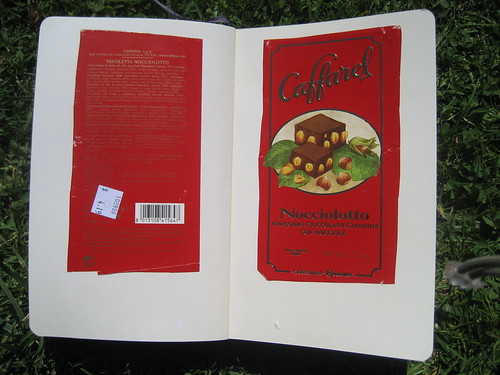
this bar is a little too rich and sweet with the prailine intense creamy filling. cote d'or would go very far with this bar if they used a thiner paste. do a search for my other cote d'or bars and try those first.
Wednesday, December 26, 2007
cote d'or: praliné intense
dark chocolate label: what does it mean?
Healthy Dark Chocolate - What ingredients should you look for on the label?
By EatingWell, EatingWell.com
Confused about how to choose a bar that delivers real chocolate with a good dose of health-promoting flavonols? The key is high cocoa content and less sugar and dairy fat. Like milk, which lists percent butterfat by weight, good dark chocolates report their cocoa content by percent weight. Look for 70 percent cocoa or higher (the cocoa contains the flavonols). Note that milk chocolate may have no more than 10 percent cocoa and pure baker’s chocolate is too bitter for eating out of hand.
Many people find 70 percent cocoa somewhat bitter at first but soon come to appreciate the richer taste and lack of sugar. With the intense flavor of higher cocoa content, a small portion can easily satisfy chocolate cravings. When cocoa percent is not listed—and many labels are truly confusing—the first ingredient on the label should be cocoa, cocoa liquor or cocoa solids. Some common chocolate label terms:
• Cocoa liquor (chocolate liquor): After fermenting and roasting, the inner cocoa bean nibs are crushed and heated. The combination is ground to a thick paste made up of cocoa solids and cocoa butter. Despite the name, it contains no alcohol.
• Cocoa solids (cocoa powder): The dry paste, rich in flavonols, left when cocoa butter is removed from cocoa liquor.
• Cocoa butter: The ivory-colored cocoa fats that can be separated out of cocoa liquor. Cocoa butter lends chocolate a smooth texture and wealth of flavor (without cocoa solids, it forms the basis for white chocolate).
• Vanilla (pure extract, sometimes called Bourbon): A natural flavoring; adds a complementary perfume to chocolate.
• Vanillin: A less expensive, artificial substitute for pure vanilla that many tasters consider inferior.
• Lecithin: A nutritionally acceptable emulsifier to keep fats from separating out of the chocolate and to give a smooth consistency and longer shelf life. Usually derived from the fats in soybeans.
Tuesday, December 18, 2007
better than red wine or green tea
Source: Cornell University
Date: 2003-12-19
Ahhhh! Better Than Red Wine Or Green Tea, Cocoa Froths With Cancer-preventing Compounds, Cornell Food Scientists Say
ITHACA, N.Y. -- There is a new reason to enjoy hot cocoa on a cold winter's night in front of a cozy fire. Consider it a health drink.
Beyond the froth, cocoa teems with antioxidants that prevent cancer, Cornell University food scientists say. Comparing the chemical anti-cancer activity in beverages known to contain antioxidants, they have found that cocoa has nearly twice the antioxidants of red wine and up to three times those found in green tea.
Their finding will be published Dec. 3 in the American Chemical Society's Journal of Agriculture and Food Chemistry , a peer-reviewed publication.
Scientists have long known that cocoa contains antioxidants, but no one knew just how plentiful they were compared with those in red wine and green tea.
The Cornell researchers, led by Chang Y. (Cy) Lee, chairman of the Department of Food Science and Technology at the university's New York State Agricultural Experiment Station in Geneva, N.Y., say the reason that cocoa leads the other drinks is its high content of compounds called phenolic phytochemicals, or flavonoids, indicating the presence of known antioxidants that can stave off cancer, heart disease and other ailments. They discovered 611 milligrams of the phenolic compound gallic acid equivalents (GAE) and 564 milligrams of the flavonoid epicatechin equivalents (ECE) in a single serving of cocoa. Examining a glass of red wine, the researchers found 340 milligrams of GAE and 163 milligrams of ECE. In a cup of green tea, they found 165 milligrams of GAE and 47 milligrams of ECE.
"If I had made a prediction before conducting the tests, I would have picked green tea as having the most antioxidant activity," said Lee. "When we compared one serving of each beverage, the cocoa turned out to be the highest in antioxidant activity, and that was surprising to me."Phenolic compounds protect plants against insects and pathogens, and they remain active even after food processing. A decade ago "food scientists did not know that phenolics had an important role in human health," says Lee.
Lee and his colleagues used two chemical tests that measured how well the cocoa compounds scavenge for free radicals -- agents that cause cancer, heart disease and other diseases.
In the paper, the researchers discuss eating chocolate bars instead of drinking cocoa. "Although a bar of chocolate exhibits strong antioxidant activity, the health benefits are still controversial because of the saturated fats present," the researchers write. They explain that cocoa has about one-third of a gram of fat per one-cup serving, compared with eight grams of fat in a standard-size 40-gram chocolate bar.
Faced with the confusing prospect of drinking red wine or green tea or cocoa, Lee suggests enjoying all three in different parts of the day. "Personally, I would drink hot cocoa in the morning, green tea in the afternoon and a glass of red wine in the evening. That's a good combination," he says.
The research paper is titled "Cocoa Has More Phenolic Phytochemicals and a Higher Antioxidant Capacity than Teas and Red Wine." Lee's collaborators are his former graduate student, Ki Won Lee; Hyong Joo Lee, a professor at Seoul National University, South Korea; and Young Jun Kim, a post-doctoral researcher at Cornell. The research was funded in part by the BioGreen 21 Program, Rural Development Administration, Republic of South Korea
Monday, December 17, 2007
the world is flat, and chocolatiers want to coat it
December 17, 2007 - Zurich Journal - By JOHN TAGLIABUE
Teuscher, a luxury chocolate emporium on the bustling Bahnhofstrasse in Zurich, helps make the Swiss city a haven for those with a sweet tooth and a well-filled wallet.
ZURICH — When the cold winter wind blows off Lake Zurich, the people who live around this sprawling factory, a 10-minute ride from the center of town, can smell the chocolate in the air. It is especially pungent this time of the year, when the factories are humming to meet holiday demand, the chocolate-maker’s bonanza.
“Some people who live around a factory mind the odor,” said Sara Bouachir, an official of Lindt & Sprüngli, the $2.1 billion-a-year Swiss chocolate giant that runs the factory. “But not here.”
But factories like this face a challenge. The Swiss already consume an average of more than 25 pounds of chocolate a year, placing them second only to the British, so how do you get them to eat more? This is driving the chocolate-makers of Zurich to new heights of innovation, with dark chocolates flavored like hot chili peppers, grappa or saffron.
It is also making Swiss chocolate a case study in globalization. Swiss chocolatiers, having long ago conquered markets in Europe and North America, are now aiming at the vast expanses of Russia, India and China.
Zurich itself remains a haven for chocolate-lovers, with cozy chocolate shops nestled among the big Swiss banks, like UBS and Credit Suisse, along the noble Bahnhofstrasse. Stores like Teuscher and Sprüngli stand next to luxury shops like Cartier and Chanel.
“People are more and more sensitive about quality; they buy less but higher quality,” said Ms. Bouachir. “People do tastings, as with wine, and they want to know the background of their chocolate.”
The people of Zurich are the beneficiaries of a process that they, who still refuse to join the European Union, fear in other areas — the free movement of goods across national borders. In just the last 10 years, Lindt & Sprüngli has opened a global chain of Lindt Boutiques, with more than 100 in the United States alone. Now, Ms. Bouachir said, visitors from India and Thailand are coming to see how it is done.
Peter Bauer, 41, a pastry chef in a small shop a five-minute walk from the Lindt factory, has been leading the search for new kinds of chocolates. He is the moving force behind the emergence of dark, single-variety chocolates, concocted of beans from a single region.
“Eighty-eight percent of people would say it’s too bitter, but I say it’s great,” he said, as he kneaded a ball of pastry dough, laced with pistachios. He loves munching dark chocolate in front of the television, he said. “But take any five Swiss people, and three will say they prefer milk chocolate.”
This preference for the tried and true is a major issue for the big chocolatiers of Zurich, like Barry Callebaut, a $3.5-billion global chocolate bean merchant whose offices fill several floors of an office building in a shabby corporate park on the edge of Zurich. From here, Barry Callebaut’s pinstriped-suited global sourcing experts, huddling in conference rooms named for chocolate-producing places like Ecuador and São Tomé, buy cocoa beans, sugar, powdered milk and other ingredients for making chocolate in industrial quantities.
One floor below is a chocolate academy, where the company trains pastry chefs and bakers to use chocolate. Barry Callebaut runs seven huge chocolate factories, including two in Switzerland, from which it supplies industrial chocolate to the likes of Hershey, Nestlé and Cadbury Schweppes. It also has its own consumer brands, like Van Houten and Van Leer. Listed on the Zurich stock exchange, its shares have soared more than 50 percent this year.
The strategy Barry Callebaut employs to lure the Swiss into eating more chocolate is essentially the one it uses to seduce consumers globally: emphasizing chocolate’s contribution to good health (some studies have found that dark chocolate may be good for the heart); pitching it as a taste experience; and making it as conveniently available, in stores or vending machines, as food or drink.
“Clearly there’s a trend toward dark chocolate, and single-origin chocolate,” said Gaby Tschofen, of the company’s management board. “But consumers also want chocolate they’re used to. Chocolate is your little luxury.”
Some say the Swiss are saturated. “You could give chocolate away, not for free, but for much cheaper,” said Franz Urs Schmid, director of Chocosuisse, the chocolate-makers association. “But it wouldn’t increase the quantity the Swiss consume.”
Then, too, in coming months the Swiss may have to pay more for their chocolate, Ms. Tschofen said. The price of powdered milk, a prime ingredient, has doubled over the past year.
Chocolate even got caught up in the credit squeeze that has afflicted financial markets this year. Hedge funds, on the lookout for lucrative investments, had gone into cocoa beans, driving the price up, she said, but had to sell their stocks when the financial crisis hit, causing the price of beans to drop again.
Walk along Bahnhofstrasse, and the trend to single-source chocolate is evident everywhere, in chocolate made of beans exclusively from one country, be it the Dominican Republic, São Tomé or Ecuador. Many are spiced exotically.
Stepping out of Teuscher, one of the leading chocolate shops, Raico Pschichholz, 29, a health care worker on a holiday weekend from Berlin, said he had just purchased two bars of chocolate, one filled with pralines, a soft pasty layer, and another with rose pepper. “I recently found one in Berlin with grape and goat cheese,” he said proudly.
Barry Callebaut is not waiting for the Swiss to eat more chocolate. This year, it opened a factory near Moscow, and in January will inaugurate another near Shanghai. “In North America, it’s the eight weeks prior to Christmas,” Ms. Tschofen said, listing the world’s chocolate-eating seasons. “In Germany it’s still Christmas, in Russia it’s New Year’s, and in Japan it’s St. Valentine’s Day.”
For Sergio Braunschweiler, 31, a Swiss banker, it is any time of the year. When he buys chocolate, he said, stepping out of Sprüngli, “then the darker the better.”
Wednesday, December 12, 2007
recchiuti: free chocolate bar for christmas
i just received a sweet letter from michael recchiuti of recchiuti san francisco.... here is an excerpt...
Before I sign off, I just want to say thanks to and everyone out there who's supported Recchiuti over the years. We're celebrating our 10th anniversary. Can you believe it? Me neither...You guys are the ones who keep me motivated to come in here everyday and make chocolate. From the bottom of my heart, thank you.

to get your free recchiuti 4-oz chocolate bar through december 18th, enter the promo code "gr808" on the checkout page. bummer it's only available on web orders. share the love. spread the code.
if you are going to make an order, my recommendations include: the feve bar, fleur de sel caramels chocolate, burnt caramel almond chocolate, and the key lime pear chocolate.
chocolate prevents heart attacks and relieves heart break
Dark chocolate acts as aspirin, study - By Catherine Boal15/11/2006 -
Cocoa can function in the same way as aspirin in preventing heart attacks, according to a new study investigating its effect on blood platelets.The research will lend further weight to the various health claims now attached to the traditional indulgence.
Dark chocolate has recently been making inroads into the health market as its beneficial antioxidant and flavanoid content becomes more widely publicised and consumers switch from milk or white chocolate to keep up with the trend.
Scientists at the John Hopkins University School of Medicine say that a few squares of chocolate a day can reduce the risk of a heart attack by almost 50 per cent in some cases.
The discovery came after volunteers for a trial on the effects of aspirin were disqualified for eating chocolate, despite being warned that this would interfere with results from the study.
Despite being barred from participating in the drug study, the chocolate-eaters blood was examined and compared with others who hadn't indulged in order to determine what effect cocoa has on platelets.
Platelets from those who had eaten chocolate clotted more slowly than those who had not - taking an average of 130 seconds to clump together compared to 123.
Professor Diane Becker said: "What these chocolate 'offenders' taught us is that the chemical in cocoa beans has a biochemical effect similar to aspirin in reducing platelet clumping, which can be fatal if a clot forms and blocks a blood vessel, causing a heart attack."
She continued: "Eating a little bit of chocolate or having a drink of hot cocoa as part of a regular diet is probably good for personal health, so long as people don't eat too much of it, and too much of the kind with lots of butter and sugar."
The full results of the study were presented to the American Heart Association's annual Scientific Sessions in Chicago yesterday.
http://www.foodnavigator.com/
Monday, December 10, 2007
los angeles international chocolate salon: amano
my, my, my... these gentlemen put out an incredibly superior product! art pollard (left) and rick raile are committed to finding the best beans that go directly to the bar. they are "dedicated to reviving the art of making fine artisan chocolate from the bean. [the] chocolate is made in small batches from only the finest cacao beans and the most selected ingredients."
i would suggest having your local chocolatier carry their product. http://www.amanochocolate.com/

los angeles international chocolate salon: vermeer
i am not a fan of most chocolate liqueurs... sure, i always add them to my cakes or to an espresso on a cold night... but i never would imagine drinking the liquers straight because they are way too sweet.
vermeer is an amazing exception! it is a gentle liqueur made of dutch chocolate, cream and vodka. your friend maurice kanbar, the inventor of SKYY vodka, concocted this spirit. vermeer can be consumed with ice on the rocks, and it can be mixed in a chocolate martini cocktail or added to coffee or hot chocolate.
vermeer is 34 alcoholic proof (17% alcohol by volume) and the bottles are labeled with an image of johannes vermeer's girl with a pearl earring. www.vermeercream.com/
freddy baggerman of vermeer is such a delight. he is pictured below.

los angeles international chocolate salon: cocoa privé
i am so glad i attended this salon... betsy schoettlin, artisan chocolatier of cocoa privé, is quite a fabulous and eccentric character - - - which definitely shows in her chocolate. she carried the most phenomenal chocolates: goat cheese truffles, kalamata olive truffles, prune filled with irish whiskey ganache, ginger topped apricot covered in chocolate, chipotle marshmallow smore, australian glazed apricot with stilton and walnut ganache... all of which were absolutely divine.

los angeles international chocolate salon: the chocolate traveler
i recently gave a poor review of the chocolate traveler's holiday dark chocolate. this review completely pained me since i remember the beginnings of my chocolate snob days of always carrying around a tin of chocolate traveler (70% dark chocolate) in my car. after tasting the holiday dark chocolate, i was worried about the quality.
i was a tad apprehensive to meet the chocolate traveler group... but i wanted to understand what was really going on with their chocolate. i met with jon alberon and he stated that the chocolate in the holiday tin was around 33% and that it was targeted to consumers who were not prepared for the higher cacao content.
Friday, December 7, 2007
champion: noir praliné - aux éclat de noisettes caramélisées

hazelnuts, filberts, cobnuts... how ever you call them... those babies caramelized and put in chocolate is my idea of a great time. this bar has a delicate soft crunch... just lovely, although it is a bit on the sweet side.
the french are absolutely superb when it comes to food and love! i cannot believe that this is the generic brand for champion stores. dix milles bisous.
los angeles luxury chocolate salon on sunday, december 9th, 2007
I am pleased to be on the tasting panel! Please join me in this event...
Discover, taste and savor the finest in artisan, gourmet and premium chocolates & wine
Chocolate lovers, en garde! The first major chocolate show in the Los Angeles area this millenium takes place at the Los Angeles Luxury CHOCOLATE SALON on Sunday, December 9th, 2007 at the Pasadena Center. Chocolate aficionados, fanatics, lovers and addicts can taste & experience the finest in artisan, gourmet & premium chocolate in one of the world's great culinary metropolitan areas.
Salon highlights feature chocolate tasting, demonstrations, chef & author talks, wine tasting and ongoing interviews by TasteTV's Chocolate Television program. (Salon Entry includes all chocolate & wine tastings, demos, etc.).
A sample of salon participants includes L'Artisan du Chocolat, Mignon Chocolate, Decadent Tastes, Yum! Chocolate, Vermeer Dutch Chocolate Cream Liqueur, Chuao Chocolatier, Guittard Chocolate, The Chocolate Traveler, Malibu Toffee, Cocoa Prive, The TeaRoom, Amano Artisan Chocolate, Chocolate Covered Company, Randy Fuhrman Events / Randy's Brownies, Silver Stone Wines, Vihuela Winery, Sol Rouge Winery, C'est Tres Chic Chocolate Molds, Le Creuset, Swissmar, Putumayo World Music, Chocolate Television, and much, much more.
Go here: luxurychocolatesalon.com or lachocolatesalon.com
Thursday, December 6, 2007
if it ain’t dark, it ain’t chocolate
The new breed of chocolate snobs
By Lessley Anderson and James Norton (chow.com)
Not long ago, Seth Wolf’s wife found something in her husband’s possessions that shocked her. Was this the man she knew? Was he harboring a dastardly secret? No, Wolf didn’t have lipstick on his collar or a hotel receipt in a phony name. He simply had a bar of milk chocolate stashed away.
Wolf adores dark chocolate, his wife knew, and looks down upon the dairy-tinged version of his favorite confection as a lower-quality food, indeed as trash. So what was he doing slummin’ it? Wolf explained that he’d bought the bar for a friend. And you better believe he was telling the truth.
The number of Americans who, like Wolf, prefer dark chocolate to milk almost doubled from 1991 to 2003. Industry types such as John Scharffenberger, cofounder of the eponymous high-end chocolate company now owned by Hershey, say dark-chocolate-lovers are actually growing at a rate of 25 percent a year. The boom is fueled by studies trumpeting the antioxidants in dark, an exploding variety of new artisanal chocolate bars, savvy marketing, and good old-fashioned elitism. And with it, a culture of snobbery has grown.
It starts with cacao percentage. Several years ago, specialty chocolatiers like Scharffen Berger began printing it on their labels. The number, a combined total by weight of cocoa solids and cocoa butter, reflects the percentage of ingredients derived purely from the cacao bean. So, the higher percentage of stuff from the bean, the lower the amount of other ingredients, like, say, sugar. Consumers began equating higher cacao percentage with better quality, because as Scharffenberger explains, “If you’re putting less sugar in it, the cacao’s gotta be pretty good. You can’t make an 80 percent out of crummy cacao—you won’t be able to eat it.”
But percentage-mongers are only partly right. “It’s not always the amount of cacao content—it’s really the bean profile and where it’s grown and how it’s fermented that dictates its intensity, its level of acidity, and its astringency,” says upscale-chocolate-maker Michael Recchiuti. “And also the roast time. There are a lot of those elements that play into percentage wars. We have an 85 percent bar, and everybody says it tastes like 65. It’s very smooth, and low in acid, and very fruity.”
Try telling that to Elissa, an editor from Sausalito, California, who asked that her last name not be used to protect her privacy. She won’t eat anything less than 87 percent. Her friends who do are “sugarholics,” she says, disdainfully.
It’s getting to the point, says David Lebovitz, that whenever this pastry chef and cookbook author leads a chocolate tasting, everyone asks him what percentages the samples are.
“Americans like high numbers,” says Lebovitz. “That’s why we haven’t switched to the metric system: 40 degrees is not exciting; 110 degrees is!”
Wine for Dummies
Adding fuel to the fire are the chocolate-makers themselves. Borrowing language from the wine world, many high-end producers are trumpeting their beans as single origin, even if the origin is an entire country like Venezuela; printing the year (called the vintage just like wine) that the beans were harvested on the label; and producing limited edition bars, made in small batches from one harvest.
“You can choose a terroir and vintage and if you taste carefully, you’ll be able to taste something of the country where the cocoa beans were grown,” reads the website of producer Chocolove.
But the analogy only sorta works. Like grapes, cocoa beans reflect the soil and weather conditions where they were grown. But you’ll have to have a great memory if you want to compare different years from the same producer.
“There’s a reason why you can’t find a flight of chocolates from 2003, 2004, 2005, and 2006,” says Clay Gordon, editor of chocolate blog chocophile.com. “By the time you get the 2006 and produce it, the 2003 is way past its peak.”
Wine ages. Chocolate rots.
Milk Is for Amateurs
Milk chocolate, meanwhile, has taken a kneecapping at the hands of those who view it as an adulterated and diluted version of “the real thing,” and others who fail to discriminate between waxy mass-market candy bars and high-quality milk chocolate.
People who like milk chocolate, says Gordon, author of an upcoming book on the confection, “have become the white-Zinfandel drinkers of the chocolate world.” The lighter the chocolate, the thinking goes, the less sophisticated it is.
“I have had people come in embarrassed,” says Adam Smith, owner of San Francisco newsstand and chocolate shop Fog City News. “They’ll sorta look around and say in a low voice, ‘Uh, I actually like milk chocolate, but my friends say I shouldn’t like it.’”
Smith, Recchiuti, Gordon, and Lebovitz all believe dark-chocolate snobs are missing out on some darn good chocolate.
“There are nuances to milk chocolate that you can never achieve with dark chocolate,” says Recchiuti. “The milk adds a different dimension to the flavor. And if you can really taste the cacao—as opposed to the first things hitting your palate being sugar and milk—then it becomes interesting.”
Recently, Smith was invited to lead a blind chocolate tasting at the Berkeley Chocolate Club in Berkeley, California. Smith was well aware that the group had a rule about only tasting dark chocolate (because most of the members like it better). However, after stealthily confirming that nobody had an allergy to dairy, Smith secretly slipped a milk chocolate sample into the lineup.
When the club members tasted the plant, there were gasps and cries of “This is very interesting!” “Cinnamon notes!” “A cheesy quality!” One person exclaimed, “Oh my God!” When Smith told them it was milk chocolate, the members amiably admitted they should, says Smith, “open their eyes to it.”
To date, the Berkeley Chocolate Club continues to taste only dark chocolate.
Wednesday, December 5, 2007
chocolate traveler: dark chocolate wedges
Monday, December 3, 2007
how to speak chocolate snob
Drop these terms, and people will know which side of the color line you stand on.
Limited Edition: A collection or single bar that’s only produced in a small run. Use it in a sentence this way: “Godiva was just crappy mall chocolate until it started offering its limited-edition G Collection.”
Percentage: Short for the total percentage of ingredients in a particular chocolate derived purely from the cacao bean. The implication is the better the chocolate, the higher the percentage. “I no longer let anything less than 70 percent touch my lips.”
Single Origin: Refers to chocolate made from beans harvested from a specific country, region, or, in the case of single estate, plantation. “I just did a tasting of single-origin Venezuelans, and the Amedei Chuao kicked Valrhona’s ass.”
Vintage: In choco-speak, this is the year the cacao beans were harvested. “I was dying to compare Valrhona Ampamakia vintages, but I discovered my last 2005 was eaten by rats.”
By Lessley Anderson and James Norton - chow.com
Saturday, December 1, 2007
Chocolate banned in Switzerland
This comes from S.J. Simon ....
Heinrich Escher, mayor of Zurich, was introduced to chocolate in Brussels in 1697 and brought it back home, where it was discreetly consumed at the feasts of the various guilds which ruled the city, until the Zurich Council banned it in 1722 as unfit for virtuous citizens. (It had a reputation as an aphrodisiac.)
The Swiss in general had to wait several decades before wandering Italian "cioccolatieri" brought the drink to Switzerland. The first chocolate manufacture was set up around 1750 by two Italians in a former paper mill near Bern, the Schermenmühle. It was not a great success: the locals did not take to it, and the mill was soon given over to producing flour instead. Nevertheless, before the end of the century other factories appeared in western Switzerland - Vevey, Morges and Lausanne - and in the Blenio Valley in canton Ticino. The first chocolate shop in Switzerland opened in Bern in 1792.
from: http://www.swissworld.org/en/
lazaroni: bittersweet chocolate with amaretti di saronno
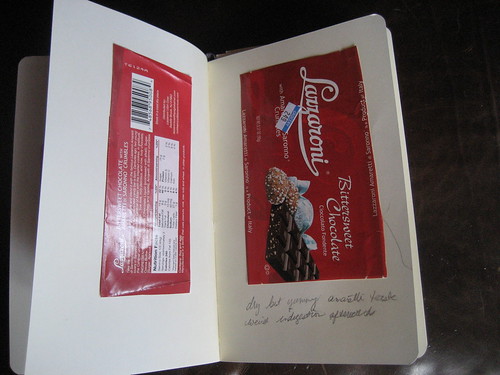
dry chocolate but yummy amaretti taste. i had very weird indigestion after this tasting. get it for the novelty and stock up on zantac. or, the best bet... get a fine chocolate for melting, add crushed amaretti di saronno into it, mold, then eat. also, be sure to impress your friends by lighting the amaretti papers for a rocket launch... here is how to do it.... roll the amaretti wrapper, light it from the top, and watch it lift off.
chocolove: ginger crystallized in dark chocolate 65% cacao
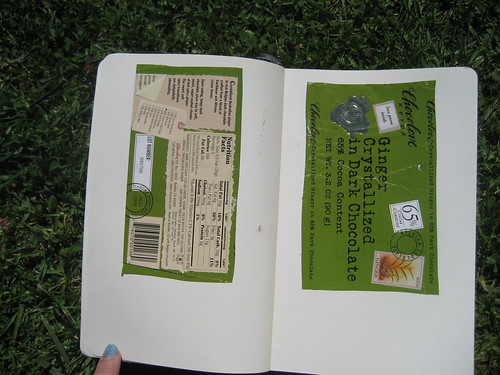
i am really perplexed by chocolove. the packaging is really great, the content of the cacao is impressive, and crystallized ginger with chocolate is a great twist in the bar world..... unfortunately, the chocolate is not quite mesmerizing. i wish it had a smoother bite to fully enjoy the ginger... the bar is chalk like in texture. all in all, i recommend this bar as a gift to the novice chocolate snob.
Tuesday, November 27, 2007
kinder : happy hippo

this was such a fun treat from rafal and dean. they picked up this happy hippo in spain. i loved it with all snobbery aside! It is comprised of a wafer shell surrounding a soft chocolate center.
Monday, November 19, 2007
grilled chocolate sandwiches
this is from our friend Vanessa Balchen at what geeks eat.com
When I made my first brioche for World Bread Day I knew it wouldn’t be my last. Over the past few weeks I’ve thought about how best to combine brioche with chocolate…and then I was making grilled cheese sandwiches and it came to me. I told the guys I was making grilled brioche and chocolate sandwiches and Alex said, “A chocolate sandwich?!!? You can’t do that…it’s crazy!!”. Oh yes I can you silly boy…just watch me! After the brioche came out of the oven and cooled I sliced the loaf in two and gave half of it up to the guys…it was gone in minutes. The other half I hid for another day…I wanted it to be slightly stale when I grilled it up.
These little babies couldn’t be simpler and really pack a huge “WOW” factor. Slice the brioche, butter it, put your favorite chocolate in the center, top it with another buttered slice of brioche and grill it to a golden brown. My only tip is to grate the chocolate in the food processor to ensure it will melt all the way through. The finished product was a magnificent combination of chocolate and tender, stretchy brioche. Everyone loved it. I’m content for now but I bet there are other chocolate and bread combinations I need to try. Do you know of any?
How Chocolate Can Save the Planet
 by Joanne Silberner Morning Edition, November 19, 2007 · Many people agree that chocolate is good for the soul, and researchers are finding that chocolate can be good for the body, too. But the environment? How could chocolate help with global climate change?
by Joanne Silberner Morning Edition, November 19, 2007 · Many people agree that chocolate is good for the soul, and researchers are finding that chocolate can be good for the body, too. But the environment? How could chocolate help with global climate change?The answer is found in a little piece of paradise, a patch of rainforest in eastern Brazil. Everywhere you look, something is growing. Orchids nestle in the crooks of trees. There are hundreds of shades of green, and the forest is loud with birds and insects.
Some areas have been thinned out and planted with cacao trees — the source of chocolate. The pods contain the magical beans that Aztecs counted like gold. The cultivated cacao trees grow just a bit higher than a man can reach, and rainforest trees tower over them like something out of Dr. Seuss — some round like lollipops, some flat like a plate.
And here's the climate connection. Rainforest trees and plants store massive amounts of carbon — keeping it from getting into the air as carbon dioxide.
That worries Dario Ahnert, a plant expert at the State University of Santa Cruz in Eastern Brazil. He says farmers need an incentive to save the remaining forest, and he hopes chocolate will be that incentive.
Chocolate used to be a huge industry here, but in the past two decades, plant disease and low prices in the world market for cocoa beans devastated the industry. Farmers turned to other ways of making a living, including logging trees or burning the forest for farmland or pasture. When the nutrients in the soil were used up, the land was abandoned.
Ahnert wants to persuade farmers to return to chocolate farming and preserve the forest. His friend, Joao Tavares, shows it can be done.
Cabruca Farming
Inside Tavares' cabruca forest, the ground is covered in a thick layer of composting leaves. It's moist, shady and cool here in the cabruca. Football-shaped pods — striped in yellow and green and orange and brown — jut out from the trunks and branches of the cacao trees.
Tavares has worked hard to maintain, and also to restore, his little piece of the rainforest. He says that in the past 10 years, he has planted many wild trees.
There's also an expanding market for environmentally friendly chocolate. Tavares has been able to get a premium for some of his crop.
Carbon Credits for Farmers?
Still, his friend, professor Ahnert, admits that cabruca is a tough sell: Farmers want more so-called modern approaches and quicker money. That's why Ahnert hopes that cabruca can become part of the carbon credit market. Farmers would then get money for preserving forest trees, as well as for their chocolate.
"You could increase the income, so I hope some day people that maintain this area are able to get carbon credits," Ahnert says.
The World Agroforestry Center and the chocolate manufacturer Mars Inc. are currently studying how carbon storage can be measured on cabruca-like farms, and whether a carbon credit system would help farmers — and the environment.
Reviving the Land through Chocolate
And there's an even more ambitious idea out there. Howard Shapiro, chief agronomist at Mars, hopes that chocolate could even bring back a little of the forest paradise that's been lost.
He's doing tests with local scientists at Brazil's national chocolate research institute.
"This is an area that's been planted on degraded land," Shapiro says, giving a tour of the three-acre research plot.
"What we decided to do was, we would begin with annual crops," Shapiro explains. "Corn, beans — things that have a cash crop value — melons, squashes, and begin to establish bananas for shade, then start to plant cacao."
They also planted rubber trees, and heliconium flowers. The first plants went in seven years ago. Now it's easy to grab a handful of soil. It's dark brown, moist and crumbly, like devil's food cake — with worms. But the worms are good for the soil.
"See all the little flowers on this tree?" Shapiro asks, pointing to a cacao tree. "All those little pink buds. … It's healthy. These trees are healthy."
Shapiro wants to work out the details, but he's ready to say the project is a success. "We learned that you could take totally abandoned land, and you could restore it to profitability after about three years," he says.
Produced by Anna Vigran
chocolove: hazelnuts in milk chocolate 33%
Gentle, delicious, and sweet... then again, the poem inside may have worked me over a bit....
by Anne Bradstreet
If ever two were one, then surely we.
Wednesday, November 14, 2007
amedei: chuao cioccolato fondente bitter chocolate extra 70%
cioccolato fondente bitter chocolate extra 70%.
want to taste a bit of heaven? want to hang out with angels? this bar is so heavenly i feel my sins disappear with each bite. amadei is so close to god.
the seeds are produced in the venezuelan penninsula of chuao.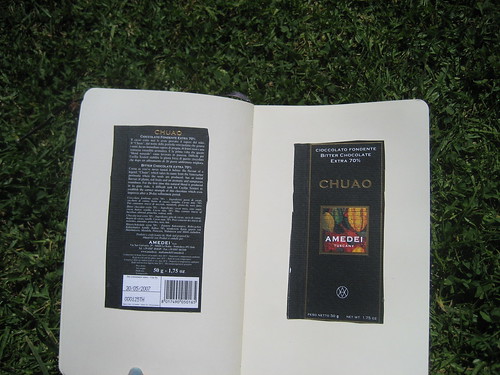
villars: swiss milk chocolate wtih 30% whole hazelnuts
yum, yum, yum. very swiss, very milk chocolate, and wonderful whole hazelnuts. great for the non-dark chocolate folks.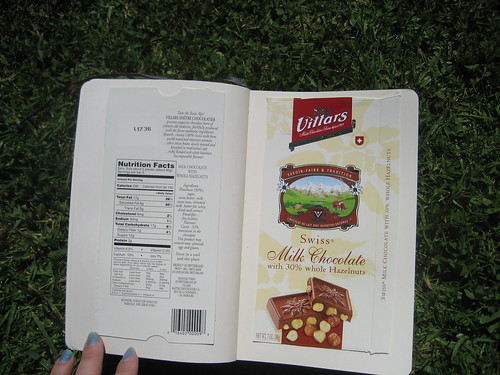
theo chocolate: 3400 phinney coconut curry
i really love odd combinations in chocolate. however, with this one, the coconut curry bar lacks any hint of subtlety. the immediate crash of flavors deadens the palate and there is no need to search for any nuance. they are so close to making a perfect combination - - - i just wished they did not dump the entire indian kitchen in this sweet. stick with vosges on this one.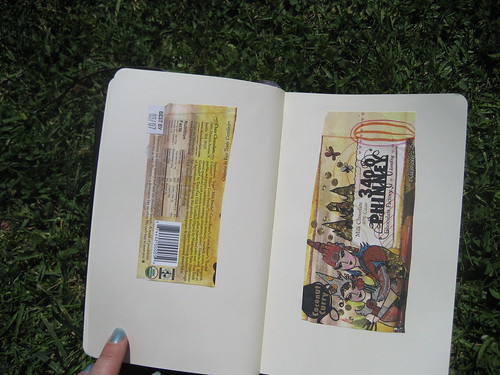
coppeneur: uba budo
sao tome & principe - agua grande plantation uba budo vollmich chocolade 52% cacao forastero mit himalaya-salz & caramel.
sacrifice everything and get this bar. delicious, gentle, yet bitter. you tease! there is a lot of hypnotic aftertaste that lingers much like a ghostly smokey aperitif. the packaging is divine... complete with a wax seal and booklet. GET THIS FINE DELICACY!
chocolate aguila: chocolate
waxy mess of a chocolate that i picked up in argentina. it does, however, make a great hot chocolate. oddly enough, mike ordered a hot chocolate at the eze airport upon our departure. he was handed hot milk and a little bar of this national chocolate to stir into his drink.
aguila d'or : relleno cappuccino
gentle soft strong cappuccino flavor that is tremendous. i found this fun treasure in buenos aires - chocolate semiamargo relleno con mousse sabor cappuccino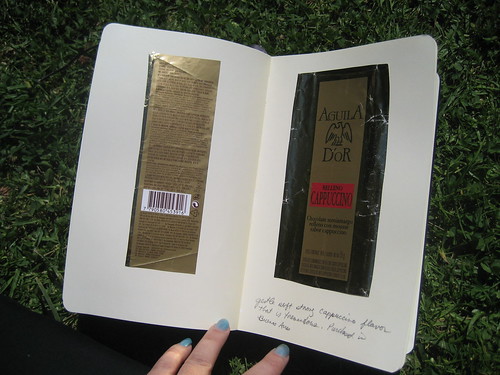
Tuesday, November 13, 2007
pre-dating the love of chocolate
 by Anna-Marie Lever Science and nature reporter, BBC News
by Anna-Marie Lever Science and nature reporter, BBC News
Chemical and archaeological evidence has pushed back the earliest known use of cacao, the key ingredient of chocolate, by 500 years.
The chemical compound, theobromine, which only occurs in the cacao plant, has been found on pottery vessels dating back to as early as 1000 BC.
Experts say the vessels were used to serve a fermented cacao drink that was made from the sweet pulp of the plant.
The vessels were unearthed at sites in Puerto Escondido, Honduras.
"The earliest use of cacao in Mesoamerica is likely to have been for a fermented drink," lead author Professor John Henderson wrote in the Proceedings of the National Academy of Sciences (PNAS).
"Such drinks may contain up to 5% alcohol in volume," the Cornell University, US, academic added.
Frothy chocolate
As well as chemical evidence, a change in pottery vessel shape allowed scientists to pre-date the use of cocoa.
It had been known that the seeds were used to make a frothed chocolate drink which became central to social life throughout Mesoamerica. It was drunk at important ceremonies to mark weddings and births, especially by elites.
As the drink was frothy, it was served in a spouted bottle with a flaring neck. However, long-necked bottle samples that pre-date the spouted bottle were also found to contain cocoa residues.
The researchers suggested that this vessel type was inappropriate for frothing but better for pouring.
This led the authors conclude that "early cocoa was consumed as a fermented beverage made from pulp", rather than seeds.
During the time of the Aztec empire, chocolate seeds were used as an early form of money.
Story from BBC NEWS:http://news.bbc.co.uk/go/pr/fr/-/2/hi/science/nature/7087899.stmPublished: 2007/11/13 06:25:10 GMT
Friday, November 9, 2007
Wednesday, November 7, 2007
chocolate and cocoa recipes by miss parloa
the digital libraries of msu has an amazing collection of historic cookbooks. chocolate and cocoa recipes is indeed a treasure. there is historical content as well as many pages of recipes with illustrations.
Tuesday, November 6, 2007
bernard callebaut chocolate package
i received an incredible care package of chocolate yesterday from my good friend brad of bernard callebaut. victoria, b.c. canada 623 broughton street 250.380.1515 .
what an amazing delight of chocolate bars (60% cacao dark chocolate with hazelnuts, white chocolate with pistachios...), baking chocolate (72% cacao, 60% cacao, and 35% cacao), chocolate shavings (already used in my latte this morning - yummy), a box of truffles and filled chocolates, hot fudge sauce, and caramel sauce. this will take some time for tasting.... but yes, I have started already... the dark chocolate with hazelnuts is heavenly. a more detailed review is coming soon.
thank you brad! you rock!



Wednesday, October 31, 2007
easy chocolate truffles
Ingredients:
1 kg Semi-Sweet or Bittersweet Bernard Callebaut Chocolate (2.2 lbs)
0.5 Litre of whipping cream (2 cups)
0.2 kg of unsalted butter (6 oz)cocoa powder, icing sugar, or anything light
Directions:
Melt the Semi-Sweet or Bittersweet Bernard Callebaut Chocolate over a double boiler.
Warm the whipping cream and melt the unsalted butter in the cream.
Add the melted Chocolate, to the cream while you stir. Add flavoring if you wish.
Pour mixture in baking trays (1 inch thick). Let cool in fridge till the mixture is hard.
Scoop small pieces with a melon-baller or a coffee spoon. Roll pieces by hand into round or oval shapes.
Roll the Truffles in cocoa powder, icing sugar, or anything light.
the best dark chocolate mousse recipe
this recipe is from my good canadian friend brad at callebaut chocolate in victoria, british columbia
Ingredients:
1/3 cup White, Granulated Sugar (80 ml)
6 tbsp Prepared, Strong Coffee (90 ml)
7 ounces Chocolaterie Bernard Callebaut Dark Chocolate (225 g)
4 tbsp Heavy (Whipping) Cream (60 ml)
3 Large Egg Whites
1½ cups Chilled Whipping Cream (300 ml)
Directions:
In a saucepan, dissolve sugar in coffee over medium heat. Set aside.
In the top of a double boiler over hot, (not simmering) water, melt the dark chocolate, stirring constantly, until smooth. When completely melted, whisk in the 4 tablespoons of cream and the coffee/sugar mixture. Stir until smooth. Allow to cool.
Beat egg whites to soft peaks. Gently fold in ½ cup of the chocolate mixture. Pour this latter mixture back into the chocolate mixture, folding gently. Beat chilled cream to soft peaks, and fold in gently until totally mixed.
Pour mousse into a large serving bowl, or 8 individual dessert glasses. Chill for 4 hours.
(Makes 8 Servings)
Martha Moore,Victoria, British Columbia
Tuesday, October 30, 2007
frans: grey salt caramels

cote d'or: noir amandes
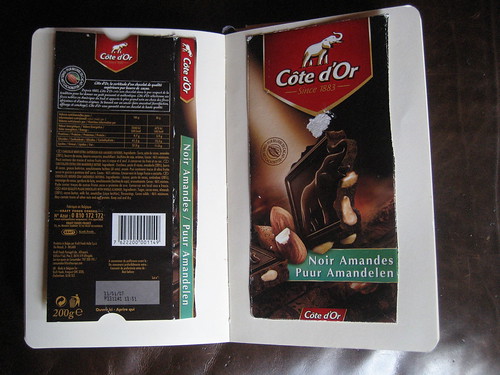
vosges: woolloomooloo bar
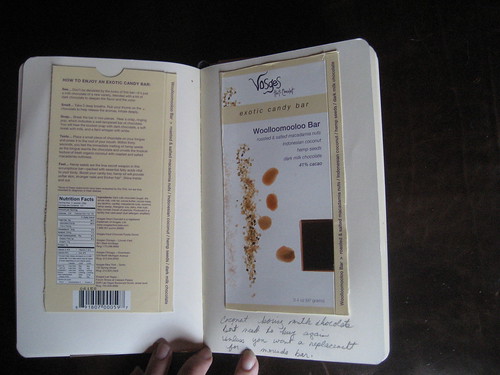
scharffen berger: 70% cacao bittersweet
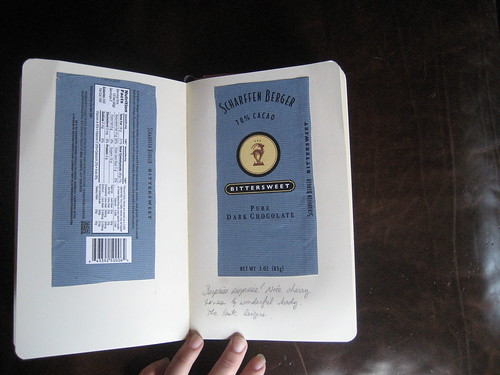
chocolove: cherries & almonds in dark chocolate
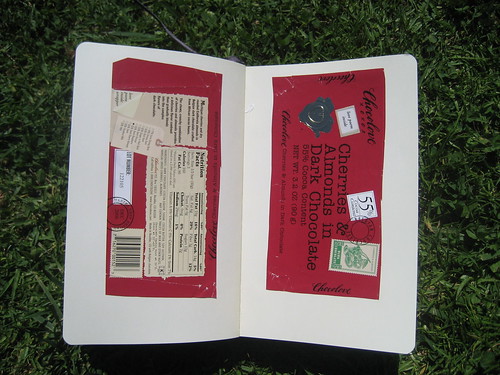
caffarel: nocciolotto
lindt: intense orange

green & black : mint bittersweet
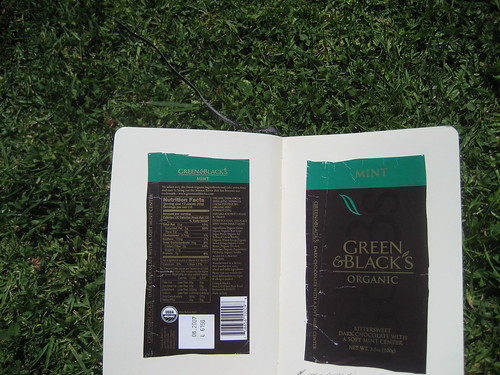
amedei: Toscano 'Red' Dark Chocolate Bar with Dried Berries

absolutely positively delicious. love the popping berries in my mouth. decadent heavy chocolate taste.
Tuesday, October 2, 2007
caffarel: finissimo cioccolato gianduia
this has to be one of the finest chocolates ever made. the hidden hazelnuts and the warm coating of chocolate are indeed heavenly. for those afraid of dark chocolate, this would definitely be your best best.
charlemagne: topsy turvy violette
a bit on the sugary sweet perfumed side... too bad it is not toned down a bit... this is for those without senses
richard donnelly: hazelnut almond toffee
fun and light toffee delight. this bar is simple and uncomplicated pleasure. the gorgeous rice paper wrapping makes this a gorgeous gift.












